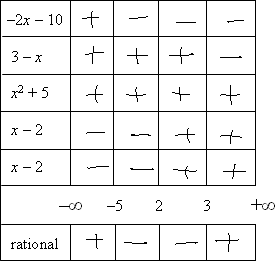Examples of Solving Rational Inequalities
Purplemath
In the example on the previous page, the sign of the rational expression alternated with the intervals. Don't assume that this will always be true.
Also, don't assume that the numerator and denominator of the rational expression will factor into standard linear factors.
Content Continues Below
Sometimes you'll get a factor that doesn't factor further, such as x2 + 4 (which has only complex-number roots); or a factor will be backwards, such as 7 − x; or all-negative, such as −5x − 15. Take the time to do things right.
- Solve the following:
This is already factored for me, so I don't have to bother with that. I'll go straight to finding the zeroes (from the numerator) and the undefined points (from the denominator):
−2x − 10 = 0
−2x = 10
x = −5
3 − x = 0
3 = x
x2 + 5 = 0
x2 = −5
no solution
x − 2 = 0
x = 2
So the number line is split into the intervals (−∞, −5), (−5, 2), (2, 3), and (3, +∞). Now I'll find where each factor is positive:
−2x − 10 > 0
−2x > 10
x < −5
3 − x > 0
3 > x
x < 3
x2 + 5 > 0
x2 > −5
always true
x − 2 > 0
x > 2
The negative factor, −2x − 10, and the backwards factor, 3 − x, have given me backwards inequalities, so the factor table looks like this:

Advertisement
(The x − 2 factor is listed twice, because that factor occurs twice. If that factor had been cubed, it would have been listed in the table three times. The x2 + 5 factor has all "plus" signs in its row, because this factor is never zero or negative.)
Affiliate
Looking at the signs in the bottom row, I see that the rational expression is negative on the intervals (−5, 2) and (2, 3). Since this problem is not an "or equal to" inequality, I don't need to consider the endpoints; I know they don't belong in the solution. But I do need to remember that x = 2 is not part of the solution, and I must resist the impulse to join these two intervals together (by throwing in x = 2) to get an incorrect solution interval of (−5, 3).
Since I can't include x = 2, the solution is two separate intervals:
(−5, 2) and (2, 3)
Note: If I'd factored the −2x − 10 and the 3 − x factors to convert them to the usual form for factors (being "(−2)(x + 5) and (−1)(x + 3), respectively), I would have gotten the same zeroes, the same intervals, and the same final answer. The only difference would have been the inclusion of one additional factor in the factor table.
First, I'd have factored:
Then I'd have found the endpoints and the signs on each interval:
2 > 0
always
x + 5 > 0
x > −5
x − 3 > 0
x > 3
x2 + 5 > 0
x2 > −5
always
x − 2 > 0
x > 2
And then I'd have filled out my (only slightly longer) factor table, and would then have read off the solution from the bottom row:

The solution would still have been the same two intervals: (−5, 2) and (2, 3)
Content Continues Below
- Solve the following inequality:
Before I can start working with this inequality, I have to gather the two rational expressions on one side of the inequality symbol, and combine them:
Affiliate
I tried to factor the quadratic in the denominator, but it's unfactorable (that is, it's prime). So I ran it through the Quadratic Formula. The zeroes turned out to be complex numbers, so it has no real-number zeroes; in particular, the quadratic's parabola never crosses the x-axis. This is a negative quadratic, which means that it opens downward; with no real zeroes, the graph is always going to be below the x-axis, so this factor is always negative.
This leaves me with the two linear factors. The factor in the numerator *can* include the endpoint where it changes signs:
2x − 5 ≥ 0
For the denominator's linear factor, I cannot include the endpoint, because this would cause division by zero:
x − 1 > 0
x > 1
Now I can do my factor table:
I recall that I cannot include 1 within the solution, because this would cause division by zero. But I am allowed to include the other endpoint. So my answer is:
(−∞, 1) and
When working these problems, remember to be careful of constant factors (like 2), backwards factors (like 3 − x), and all-one-sign factors (like x2 + 5). And make sure to be careful about which endpoints you include for "or equal to" inequalities.
But as long as you are methodical in factoring, in finding the zeros and the undefined points, and in finding the signs of each factor on each interval, you should consistently get the right answers.
URL: https://www.purplemath.com/modules/ineqrtnl2.htm
You can use the Mathway widget below to practice solving rational inequalities. Try the entered exercise, or type in your own exercise. Then click the button and select "Solve the Inequality for x" or "Solve for x" to compare your answer to Mathway's.
Please accept "preferences" cookies in order to enable this widget.
(Click "Tap to view steps" to be taken directly to the Mathway site for a paid upgrade.)
Select a Course Below
Standardized Test Prep
Homeschool Math
© 2024 Purplemath, Inc. All right reserved. Web Design by ![]()




